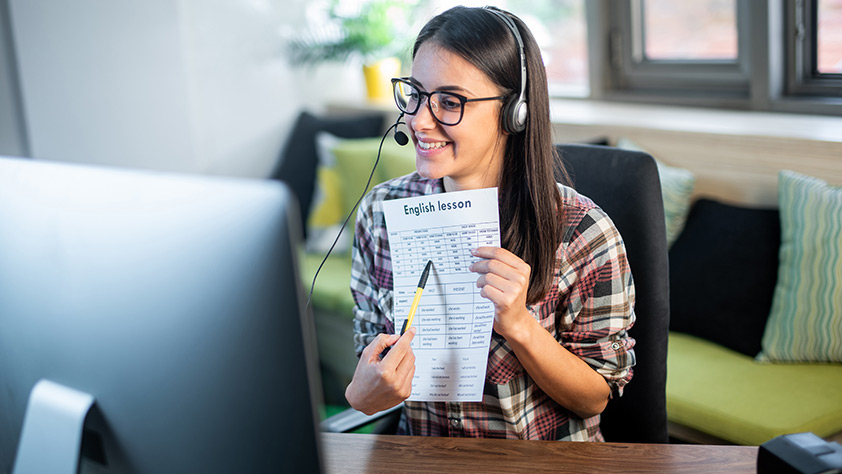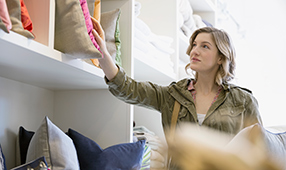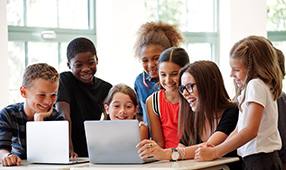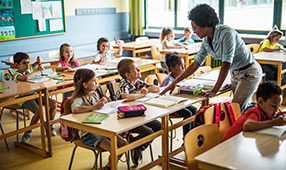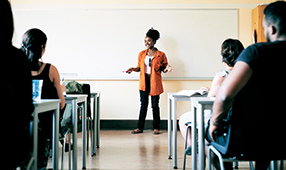As teachers shift their classrooms from the schools to their homes, NEA has put together some great tips and resources to help you adjust to teaching remotely.
With the “how” covered, you may be looking around your home thinking, “OK, but where am I going to do this?”
To help you get your space situated so you can focus on your students, we got some tips from Kathy Jenkins, a Certified Professional Organizer at Come To Order who helped 3 members in our classroom makeover videos a few years ago.
“First thing, give yourself and others some grace, because this is new for everyone,” Jenkins says.
You’re comfortable in the front of your classroom, so do your best to mimic that set up in your home. “There’s a muscle memory most teachers have Monday through Friday, 7:30 a.m. to 4 p.m., in the environment,” she says. “Replicate that at home. How your body moves, how you speak, will happen out of rote memory.”
If you were able to bring home a lot of materials from school, go through that stuff and sort out only what you need now for lessons you have planned in the next few days or weeks. Anything the students used – glues, crayons, etc. – can get stored away in a box, out of your line of sight.
Don’t worry about culling or carefully organizing extraneous items now, Jenkins says: “You don’t need the added pressure.”
Speaking of containers, you can repurpose the bins and crates that you brought those supplies home in to hold what you need easy access to during the day – and to keep important items from getting lost around the house. You also can repurpose other containers, such as shoeboxes, brown paper bags, egg cartons and the cardboard boxes that your online purchases arrive in.
Gather the items you need for your lessons as similarly as you did in your classroom, Jenkins says. “That will make you feel more comfortable and less of a fish out of water, and also keep you more organized.”
Whether you’re organizing by school days or by subjects, you can corral everything you need into separate containers so you can grab what you need. “Then it doesn’t feel like you’re scrambling every morning to start this new way of teaching,” she says.
Because this situation is temporary, Jenkins recommends repurposing what you can and buying as few new supplies as possible. You may want or need a whiteboard, which is fine if it fits your budget and you think you’ll use it later. But less expensive options such as posterboard or large rolls of white paper, taped to the wall, are just as instructive, she says.
Deciding where to set up can be tough. You might have a spare bedroom in your house, or you might need to carve out a corner of your apartment’s living room. Jenkins advises against using your own bedroom, though. “You need a place that’s sacred – a quiet place for you to retreat to,” she says.
Look for an area where you can reproduce your classroom setup as closely as possible. Did you have a second desk, or a filing cabinet, or a bookcase where you kept the day’s supplies? “Maybe you can find a small table, or use the top of your dining room buffet or a corner of the counter in the kitchen,” Jenkins says. “The more you can replicate, the less anxious you’ll feel.”
A dry-run with your tech setup can help you feel comfortable. Also consider whether you want to be sitting in front of the computer, or standing, or walking around. What do you normally do in the classroom?
If you like to walk and talk and write on the board, you need to ensure your students can see you and the board and also hear you well. Make sure your laptop camera is situated so students can see clearly. Jenkins recommends getting a Bluetooth headset so you have the flexibility to be mobile without compromising audio quality. She says a middle-of-the-road set of retractable earbuds should suffice.
Getting the lessons to sink in is another task that can be aided by organization – on the other end of the computer. Jenkins encourages telecommuting parents and their children to work near each other to stay on task.
“There’s something about the companionship – and you’re both doing the same thing – that’s motivating,” she says. “There’s an unspoken power in the camaraderie you can create, which is helpful for students because this is all new for them.”
Don’t worry if things don’t go smoothly as you’re getting acclimated to this new way of teaching. “It will feel weird at first for everyone. It’s powerful to acknowledge that,” Jenkins says. “It’s about getting into a rhythm.”
Organizing the rest of the house
Once you’re feeling good with your new “classroom” set-up, and as you’re spending more time stuck in the house, you might be eyeing closets, filing cabinets, the pantry and even the garage and getting the itch to organize.
Remember, you can’t tackle everything at once. And even though you may have time now, don’t put pressure on yourself to get a lot of things cleared out and organized. “It’s easy to think, ‘I don’t want to waste all this time,’ but it’s an odd time for everyone,” Jenkins says.
To be successful, you need to be realistic. “Don’t start with the garage and get overwhelmed and give up,” she says. “Pick a bite-sized project so you can build your muscle up. Maybe you’ve been wanting to clean out that cabinet or that closet. Then try something bigger, like the master bedroom closet or the garage. It may take time to get there, once you’re feeling more confident.” You also could rally the troops to help if you’re self-quarantined with family.
Jenkins advises her clients to follow her trusted SIMPLE method: Sort; Identity what to keep; Make a home for it; Put it in a container; Label; and Establish a system.
First, pull out everything from the area you want to organize, and sort items into categories. If you’re working in the linen closet, start by grouping the towels, the sheets, the medicine and so on. “You’ll see where you have excess when you see all the like things together,” Jenkins says. “You can see what you need to keep and what you can get rid of.”
One way to help you decide what you want to keep is to decide how much space you’re willing to devote to your belongings. If you really like shoes and don’t want to give any up, but you’ve decided that you need to keep all of your apparel within your master bedroom closet, then you’ll know you probably need to get rid of other less-desired items to stay within your allotted space.
“Once you’ve defined how much space you’re willing to give to each type of thing – clothes, sports equipment, crafting supplies – stick to that definition,” Jenkins says. “What fits in the scheme? Do I love it? How often do I use it? If I were to get rid of it, could I get another one if I needed it?”
Then, make a home for what made the cut, and put items you use often in front. “You need to be able to easily grab towels,” she says. “Comforters or extra pillows should be at very top or very bottom of the closet because you don’t need them often.” Put similar items together on shelves, in bins or in other containers.
Don’t buy containers without first finding a home for what’s in your “keep” pile. “Remember where containers are in the SIMPLE process (P = Put it in a container) and how much space you’re willing to give to a category of items,” Jenkins says. “The type and size of container you buy or repurpose depends on what you’re containing.”
Next, put a stake in the ground with labels. “Labeling is super important because it defines what’s supposed to go in the place you’ve identified,” Jenkins says. It also helps you stick with the system you’ve set up so you’ll be more likely to stay organized.
You’ll probably find that you have a lot of good items that could be donated. As more people will be squeezed as a result the economic fallout of the coronavirus, charities such as Goodwill and Salvation Army will be a resource for many basics such as clothing.
Some donation sites may be closed until it’s deemed safe to accept donations again. When you do drop off your donations, “be thoughtful of whether someone could really use it,” Jenkins says. Take time to run nice clothes through the wash so they’ll be ready for resale. And make a note about an item’s condition if it’s not in great shape. For example, a game that’s missing pieces might be useful to crafters (think Scrabble tiles), or clothing that has a broken zipper or missing buttons can be resold as fabric.
